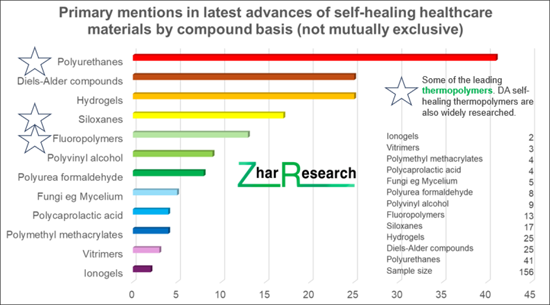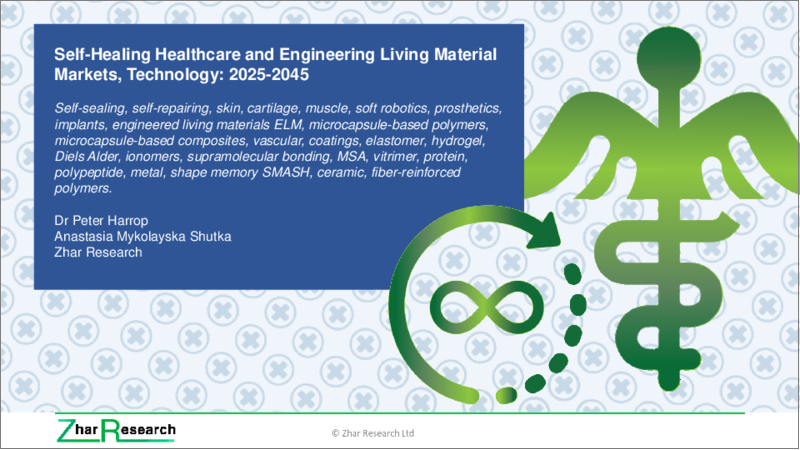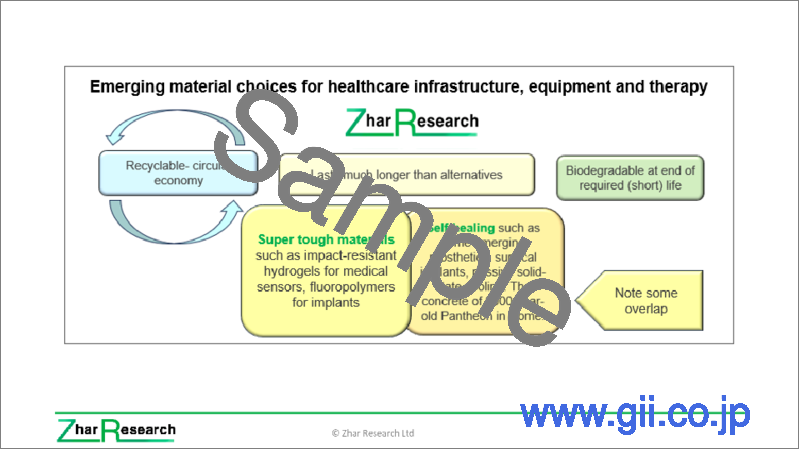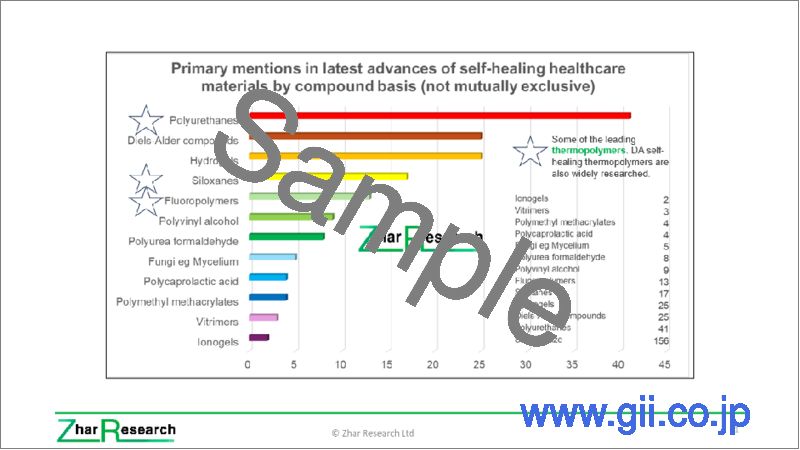|
|
市場調査レポート
商品コード
1725217
自己修復医用材料および人工設計生体材料の市場および技術:2025-2045年Self-Healing Healthcare Material and Engineered Living Material Markets, Technology: 2025-2045 |
||||||
|
|||||||
| 自己修復医用材料および人工設計生体材料の市場および技術:2025-2045年 |
|
出版日: 2025年05月15日
発行: Zhar Research
ページ情報: 英文 200 Pages
納期: 即日から翌営業日
|
全表示
- 概要
- 目次
多くの人類が120歳まで生き、その大半を健康に過ごすことを可能にするものは何でしょうか。その一つは、人間が自己修復材料によって再構築され、治療を受けることでしょう。
本レポートによれば、予測期間中は有機自己修復材料、特にサーモポリマーが市場で主流を占める見通しであり、ハイドロゲルや人工設計生体材料がシェアを獲得する見通しであると報告されています。
当レポートは、自己修復医用材料および人工設計生体材料の市場および技術を調査し、市場背景、主要技術の動向・展望、市場促進要因と課題、2025年から2045年までの17の予測ライン、68社の企業情報などをまとめています。

目次
第1章 エグゼクティブサマリー・総論
- 本レポートの目的・調査手法・背景
- 定義と焦点
- 主な結論
- 医療における自己修復材料技術の成熟曲線
- 医療における自己修復材料のロードマップ
- 市場予測
第2章 イントロダクション
- 定義と選択肢
- 市場促進要因と選択肢
- 2025年以前の自己修復材料に関する調査事例30件の分析
第3章 自己修復技術ツールキット:概要
- 概要
- 技術オプションの俯瞰:内因性および外因性メカニズム
- 自己修復の選択肢:運用・物理・化学・配合・形態
- 典型的に用いられる化学ファミリー
- 自己修復材料のための原子スケールのツールキット
- 2025~2045年に商業化が期待される用途別の主要な自己修復材料
- 自己修復性能の評価指標というジレンマ
- 自己修復ポリマーツールキット
- 内因性自己修復材料のためのツールキット
- マイクロカプセルによる外因性自己修復
- 血管構造による外因性自己修復
- 血管類似型自己修復
- 自己修復性エラストマー:内因性と外因性
- 形状記憶支援型自己修復
第4章 自己修復技術ツールキット:人工設計生体材料 (ELM)
- 概要
- ELMのSWOT分析
- 障害と今後の展望
- 生体材料を用いた自己修復アプローチ
- 生体ELMとハイブリッドELMの比較
- 2025年以前の関連研究
第5章 医療分野における自己修復材料の応用:2025-2045年
- 概要:自己修復医用材料のトピック、バイオマテリアル、ビジョン
- SWOT分析:医療分野における自己修復材料の応用
- 人工皮膚・人工筋肉:自己修復材料と、自己治癒」を支援する材料
- 組織工学、細胞共培養、臓器移植
- 人工筋肉、軟骨、義肢、ソフトロボティクス
- 骨の修復と置換
- チタンおよびその他のインプラント
- 膜
- マイクロカプセルとハイドロゲルによるドラッグデリバリー
- エレクトロニクス
第6章 自己修復企業プロファイル
- 概要・バリューチェーン
- 62社の自己修復材料製造業者の8項目比較
- 関係する14社の企業プロファイル
Summary
What will enable many human beings to live to 120 years and live healthily for most of that span? A major contributor will consist of humans being rebuilt and treated with self-healing materials. A new report details your opportunities from this. It is 347-page Zhar Research report, "Self-Healing Healthcare Material and Engineered Living Material Markets, Technology: 2025-2045" . It details how even hospital infrastructure and equipment will benefit from the new self-healing materials. Its six chapters present 10 technology SWOT appraisals, 17 forecast lines for 2025-2045. It covers 68 companies and the abundant research through 2025 is analysed to reveal winning trends and formulations. Learn which applications are likely to be large and when. See your most promising potential partners and acquisitions and your emerging competition.
Commercially oriented, balanced
The report identifies a host of opportunities for your materials specialities but is blunt about issues such as toxicity. The authors find that organic self-healing materials, particularly thermopolymers, will dominate 2025-2045 but hydrogels and Engineered Living Materials ELM will take share, so the report's balance reflects such realities.
Quick read, graphic summary
The "Executive summary and conclusions" is sufficient in itself for those with limited time. Its 51 pages include 33 key conclusions, 8 SWOT appraisals and the leading compound families that are trending, with many new infograms. See the roadmap 2025-2045 and all the 17 forecasts 2025-2045 by table and graph plus technology maturity curves for 2025, 2035, 2045. Out-of-date reports are useless for this fast-moving topic, so this one is constantly updated so you only get the latest.
Context
The Introduction (23 pages) explains definitions, choices, market drivers, the trend to self-healing smart materials, long life, reliability, fit-and-forget and rejuvenation. See how biomimetics has much further to go and how we are overcoming the soft material dilemma. Understand the challenges of putting a value on the market. 30 examples of research on self-healing materials in 2025 and earlier are analysed as a taster of what is to come.
Deep examination of your toolkit for self-healing and ELM
Chapter 3. "The self-healing technology toolkit: general" with 104 pages on the self-healing inanimate materials toolkit is brought alive with many other research advances from 2025 and earlier. Inevitably the terminology overlaps somewhat but here you can see why intrinsic self-healing and use of hydrogels, polyurethanes and Diels-Alder materials are very important. However, self-healing vitrimers, ionogels and even metals and ceramics and many others have a place, including self-healing proteins and elastomers. They are discussed in the context of various mechanisms explained. Physical or chemical approaches? The dilemmas are aired including self-healing metrics and cost-performance compromises. Understand important self-healing materials by application likely to be commercialised 2025-2045.
Chapter 4. "Self-healing technology toolkit: Engineered Living Materials ELM" (30 pages) covers self-healing versions and others not yet self-healing. ELM are engineered materials composed of living cells that form or assemble the material itself or modulate the functional performance of the material in some manner. Think enzymes, fungi and even bacteria. Overview, definition, choice of hosts and learning from nature are followed by analysis of the allied topic: assisting human healing by application of biological materials that may or may not be self-healing themselves. There is a close look at ELM features, four stages of ELM creation and deployment and a SWOT appraisal. Grasp the obstacles and the way forward for the various self-healing approaches with biological materials. Bio ELM is compared to hybrid ELM with much relevant research and commercialisation, including the current star turn - fungi - mycelial materials - with advances in 2025. See self-healing mycelial leather, formwork, ELM textiles and even concrete.
Deep study of the toolkit in action 2025-2045, latest research, 68 companies
Chapter 5. "Self-healing material applications in healthcare 2025-2045" at 100 pages is a large chapter complementing the two chapters on the technology toolkit by giving deep insights concerning the technologies in use. An important aspect is artificial human skin and muscle with self-healing materials and ones helping the patient to "self-heal".
More generally, see progress in 2025, technology trend to 2025 including sensory, electronic, biocompatibility, anti-bacterial and anti-fouling aspects comparing hydrogel, polyimine, fluoropolymer, silicone, PVA and other approaches. Understand self-healing with tissue engineering (adhesives, films etc), cell co-culture and organ replacement with objectives and progress in 2025. Scan hydrogels and PDMS in action too, soft robotics, bone repair and replacement. Here are titanium and other implants, membranes by difficulty level. Assessments with 2025 research advances include drug delivery by microcapsules and hydrogels, self-healing healthcare electronics, nanogenerators, optical and photonic materials, implantable and smart patch batteries. The report ends with 22 pages of Chapter 6. "Self-healing company profiles" comparing 62 tabled in six appraisal columns then 14 of them profiled in more detail, other being in earlier text.
The Zhar Research report, "Self-Healing Healthcare Material and Engineered Living Material Markets, Technology: 2025-2045" is your essential reading on this large emerging market for both devices and materials. Here are your exciting opportunities rising to $19 billion in 2045.
CAPTION: Primary mentions in latest advances of self-healing healthcare materials by compound basis (not mutually exclusive). Source: Zhar Research report, "Self-Healing Healthcare Material and Engineered Living Material Markets, Technology: 2025-2045" .

Table of Contents
1. Executive summary and conclusions
- 1.1. Purpose, methodology and background of this report
- 1.2. Definitions and focus
- 1.3. Primary conclusions
- 1.3.1. Addressable markets: 9 general conclusions, 3 infograms and 2 SWOT appraisals
- 1.3.2. Emerging technologies and capabilities: 24 key conclusions, 6 infograms, compound prioritisation chart, 6 SWOT appraisals
- 1.3.3. Self-healing Engineered Living Materials ELM with infograms and SWOT
- 1.3.4. Market fundamentals in infograms, pie charts and commentary
- 1.4. Maturity curves of self-healing material technologies in healthcare 2025, 2035,2045
- 1.5. Roadmap for self-healing materials in healthcare 2025-2045
- 1.6. Market forecasts 2025-2045 in 17 lines
- 1.6.1. Self-healing materials for all applications: value market 2025-2045
- 1.6.2. Self-healing materials for healthcare value market $ billion 2025-2045
- 1.6.3. Percentage share of self-healing healthcare value market by four regions 2025-2045
- 1.6.4. Percentage share of hydrogel value market by four regions 2025-2045
- 1.6.5. Global hydrogel value market by four business sectors 2025-2045
2. Introduction
- 2.1. Definition and choices
- 2.2. Market drivers and options
- 2.2.1. Trend to self-healing smart materials
- 2.2.2. Trend to long life, reliability, fit-and-forget, rejuvenation
- 2.2.3. Biomimetics - much further to go
- 2.2.4. Overcoming the soft material dilemma
- 2.2.5. Beyond biomimetics
- 2.2.6. Challenges of putting a value on the market
- 2.2.7. Stretching the logic to include minimal post treatment
- 2.3. 30 analysed examples of research on self-healing materials in 2025 and earlier
3. The self-healing technology toolkit: general
- 3.1. Overview
- 3.2. Technology options top down - intrinsic and extrinsic mechanisms
- 3.3. Self-healing options: operational, physical, chemical, formulation, format
- 3.4. Chemical families typically involved
- 3.5. Atomic toolkit for self-healing materials
- 3.6. Some of the important self-healing materials by application likely to be commercialised 2025-2045
- 3.7. The dilemma of metrics for self-healing efficacy
- 3.7.1. Quantifying healing time, maximum number of healing cycles enabled, degree of recovery
- 3.7.2. Efficiency and mobility over time
- 3.8. Self-healing polymer toolkit
- 3.8.1. Types of polymer damage to be healed
- 3.8.2. Healing options for polymers
- 3.8.3. Difficulty levels for self-healing commercialisation in polymer sectors
- 3.9. Toolkit for intrinsic self-healing materials
- 3.9.1. Overview, importance of nanomaterials
- 3.9.2. Hydrogels with SWOT appraisal, options for repairing structural damage, recovering original functions, mimicking natural healing, improvement 2025-2045
- 3.9.3. Wound healing, tissue engineering, and nerve regeneration with biocompatible self-healing cellulose-based hydrogels: research advances in 2025
- 3.9.4. Sustained hydrogel delivery of decorin to prevent corneal scarring
- 3.9.5. Wound-healing and injectable self-healing hydrogels: tissue engineering and regenerative medicine in 2025
- 3.9.6. Ionogel self healing including 2025 research advances
- 3.9.7. Silica gel
- 3.9.8. Supramolecular gels and elastomers for implantable and smart patch energy storage in 2025
- 3.9.9. Diels Alder self-healing adhesives, coatings including SWOT and latest research appraisal
- 3.9.10. Self-healing ionomers for healthcare packaging and biomedical sensors
- 3.9.11. Vitrimers
- 3.9.12. Self-healing proteins such as polypeptides
- 3.9.13. Self-healing metals
- 3.9.14. Self-healing under water
- 3.10. Extrinsic self-healing by microcapsules
- 3.10.1. SWOT appraisal
- 3.10.2. Design issues and examples
- 3.10.3. Self-healing microcapsule manufacturing options
- 3.11. Extrinsic self-healing by vascular systems
- 3.11.1. Vascular self-healing SWOT appraisal
- 3.11.2. Geometrical design and challenges
- 3.12. Vascular-like self-healing
- 3.13. Self-healing elastomers intrinsic and extrinsic
- 3.14. Shape memory assisted self-healing SMASH
- 3.14.1. Shape memory alloys and polymers and SMASH potential markets
- 3.14.2. Stress-Induced shape-shifting materials possessing autonomous self-healing and scratch-resistant ability
- 3.14.3. Hydrogel versions
- 3.14.4. Polyolefin and polyurethane versions
- 3.14.5. Close-then-heal and fiber dispersion options
4. Self-healing technology toolkit: Engineered Living Materials ELM
- 4.1. Overview
- 4.1.1. Definition and choice of hosts
- 4.1.2. Learning from nature
- 4.1.3. Allied topic: assisting human healing by application of biological materials that may or may not be self-healing themselves
- 4.1.4. Features of engineered living materials
- 4.1.5. Four stages of ELM creation and deployment
- 4.2. Self-healing Engineered Living Material SWOT appraisal
- 4.3. Obstacles and the way forward
- 4.4. Self-healing approaches with biological materials
- 4.5. Bio ELM vs hybrid ELM
- 4.6. Relevant ELM research in 2025 and earlier
- 4.6.1. Fungi - mycelial materials - advances in 2025
- 4.6.2. Self-healing mycelial leather, formwork and other applications
- 4.6.3. General research advances with ELM in 2025 and earlier
5. Self-healing material applications in healthcare 2025-2045
- 5.1. Overview: topics, biomaterials and vision of self-healing healthcare materials
- 5.2. SWOT appraisal of self-healing material applications in healthcare
- 5.3. Artificial human skin and muscle: self-healing materials and material that helps you to "self-heal"
- 5.3.1. Overview: progress in 2025, technology trend to 2025 including sensory, electronic, biocompatibility, anti-bacterial, anti-fouling aspects
- 5.3.2. Hydrogel approach
- 5.3.3. Polyimine approach
- 5.3.4. Fluoropolymer sensory robots
- 5.3.5. Silicone approach: e-skin, siloxanes
- 5.3.6. PVA, organometallic polymer and other approaches
- 5.4. Tissue engineering, cell co-culture, organ replacement
- 5.4.1. Objectives and progress in 2025
- 5.4.2. Tissue engineering adhesives
- 5.4.3. Tissue engineering films
- 5.4.4. Hydrogel approaches
- 5.5. Artificial muscle, cartilage, prosthetics and soft robotics
- 5.5.1. Overview
- 5.5.2. PDMS approach
- 5.5.3. Hydrogel approaches including as engineered living materials and SWOT appraisal
- 5.5.4. Self-healing soft robotics: US Army and others
- 5.6. Bone repair and replacement
- 5.7. Titanium and other implants
- 5.8. Membranes
- 5.8.1. Definitions
- 5.8.2. Fabricated membranes
- 5.8.3. Difficulty levels for self-healing membrane
- 5.9. Drug delivery by microcapsules and hydrogels
- 5.10. Electronics
- 5.10.1. Overview and health monitoring
- 5.10.2. Conductors
- 5.10.3. Transistors
- 5.10.4. Sensors
- 5.10.5. Optical and photonic materials
- 5.10.6. Self-healing implantable and smart patch batteries and battery parts including 2025 research advances
- 5.10.7. Triboelectric nanogenerators
6. Self-healing company profiles
- 6.1. Overview and value chain
- 6.2. Comparison of 62 self-healing material manufacturers in eight columns
- 6.3. Profiles of 14 companies involved





